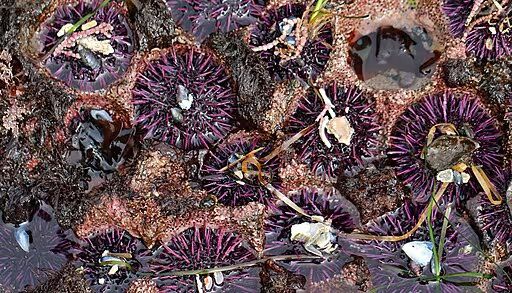Purple Sea Urchins


Purple sea urchins are one of the more common intertidal creatures found in Pacific Northwest tidepools. In recent years, you may have heard that their populations have been causing drastic damage to the kelp forests. Today we're going to take a look at these creatures and why this is happening.
Purple sea urchins (Strongylocentrotus purpuratus) are found in the eastern Pacific Ocean from Alaska to Baja California. They are found in the low and mid intertidal zones and in the subtidal up to 525 feet (160 meters). They are usually found in tidepools, crevices, and exposed rocky areas.
Purple sea urchins are echinoids enclosed in what is called a test, or a shell composed of many fused calcium carbonate plates. The shell is round and radially symmetrical (MARINe 2021). The spines (also composed of calcium carbonate), tube feet, and pedicellariae (pincer-like organs thought to help echinoderms catch food, provide defense, and keep them free of parasites and debris) are attached to the test. The test can grow up to 4 inches (10 cm) in diameter.
The spines of adult purple sea urchins are, as the name suggests, purple in color. However, in juveniles the spines can be green in color. This can cause them to mistaken for green sea urchins (Strongylocentrotus droebachiensis), which, despite their common name, can be either green or purple in color at any stage of their lifespan. They can be told apart by looking at their spinal structure as purple sea urchins have longer and thicker spines than green sea urchins.
Sea urchins use their tube feet to breathe and move around. If food lands on their backs, their tube feet can also pass it to their mouths, which are located on the underside of its test (Monterey Bay Aquarium n.d.). Their mouth consists for five plates that act as teeth called "Aristotle's lantern." They can erode small cavities into sedimentary rocks using their teeth and spines.
Purple sea urchins feed on algae, particularly large marine algae such as bull kelp and giant kelp. They usually feed on kelp detritus, but if this is scarce they will feed on live algae. They are prey to a number of species, including sea otters, sunflower sea stars, ochre sea stars, giant green anemones, and seagulls. Humans eat them as well. Purple sea urchins, particularly the gonads, are a traditional food for Native Americans throughout the urchins' range (Kuhnlein and Humphries 2017; Royal 2023).
Urchins are important in regulating kelp forest densities, but if keystone species are not around to keep their populations in check, they can grow to the point of creating sea urchin barrens. Urchin barrens are places where the urchin population is so large that their eating decimates kelps forests and prevents new ones from developing. This in turn drives away other species that depend on kelp to survive, reducing the overall biodiversity.
On the west coast, there are two keystone species populations affecting the development of urchin barrens. The first is sea otters. Sea otters were excessively hunted for their fur to the point of extirpation along significant parts of their Pacific coast range. While populations are recovering and there have been successful reintroductions in recent years, their populations still remain below historic levels.
The second is sunflower sea stars. In 2013, an outbreak of sea star wasting syndrome resulted in a 90% population loss. Sea urchins are a favored prey of sunflower sea stars, so because of the loss urchin populations have increased dramatically. The effects of this mass die-off and subsequent development of urchin barrens are a serious concern that is currently being studied.
References
Fretwell, K., & Starzomski, B. (2013). Purple Sea Urchin • Strongylocentrotus purpuratus. Biodiversity of the Central Coast. https://www.centralcoastbiodiversity.org/purple-sea-urchin-bull-strongylocentrotus-purpuratus.html
Kuhnlein, H. V., & Humphries, M. M. (2017). Sea Urchins. McGill University Centre for Indigenous Peoples’ Nutrition and Environment. http://traditionalanimalfoods.org/marine-invertebrates/echinoderms/page.aspx?id=6523
Monterey Bay Aquarium. (n.d.). Purple sea urchin. https://www.montereybayaquarium.org/animals/animals-a-to-z/purple-sea-urchin
Multi-Agency Rocky Intertidal Network. (2021). Strongylocentrotus purpuratus. UC Santa Cruz. https://marine.ucsc.edu/target/target-species-strongylocentrotus.html
National Marine Sanctuary Foundation. (2020, January 3). Sea wonder: Purple sea urchin. https://marinesanctuary.org/blog/sea-wonder-purple-sea-urchin/
Royal, T. (2023, January 3). Tribe concerned about purple urchin barrens and kelp forests. Northwest Treaty Tribes. https://nwtreatytribes.org/tribe-concerned-about-purple-urchin-barrens-and-kelp-forests/
U.S. National Science Foundation. (2022, July 25). Destruction and recovery of kelp forests driven by changes in sea urchin behavior. https://new.nsf.gov/news/destruction-recovery-kelp-forests-driven-changes
Photo 1 © Peter Pearsall/U.S. Fish and Wildlife Service
© Laura Caldwell, February 2024
Touch whale bones, examine shipwreck artifacts and connect with the coast's living history.

Support our mission, get involved in educational programs, or contribute through donations and volunteering.